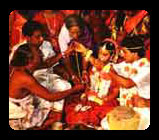THE MARRIAGE CEREMONY OF THE TAMILS
Pre Wedding
 Receiving the Groom Receiving the Groom
When the
groom and his family arrive at the wedding hall on the morning one day before
the wedding, they are welcomed with a tray containing offerings of flowers, paan
supari, fruits and mishri. Rose water is sprinkled on the groom. The bride's
brother applies a tilak of sandalwood paste and kumkum on his forehead and
garlands him. The bride's mother offers the groom's parents a sweet dish
prepared from condensed milk. A senior female member of the bride's family
performs aarti and welcomes them. It is also customary to break a coconut on the
ground as this is believed to help ward off evil spirits.
Pallikai Thellichal
The family of the bride begins this ceremony a day before the wedding. Clay pots are filled with
grains. Married women from both sides sprinkle water on the pots filled with
nine varieties of grain. During this ceremony, the others present sing
traditional songs to the accompaniment of music. The next day (the day after the
wedding) when the grains sprout, these pots are immersed in a pond so that the
fish in the pond may feed on the grains and bless the newly-weds
abundantly.
Nicchiyadharatham
The bride's parents perform Ganesh Pooja in the presence of the officiating priest. The bride is also present during the ceremony. The groom's side gives the bride a new sari. She wears it with the assistance of her sister-in-law. A tilak of chandan and
kumkum is applied on her forehead, while the pallav of her sari is filled with
fruits, paan-supari, turmeric, kumkum and coconut. A garland of flowers is tied
around her waist. Aarati is also performed for her.
Wedding
Exchange of Garlands
The bride and the groom exchange garlands thrice. The bride
and the groom's uncles (mother's brother) have to hoist them. Then, they are
made to sit together on a swing. Married women from the families give spoonful
of milk and banana pieces.
Kanyadaanam
The bride's father
welcomes the groom when he comes to the mandapam. The bride's mother applies
kajal in the groom's eyes. The bride's father washes his son-in-law's feet.
Through this gesture the father conveys that that the boy is an incarnation of
Lord Vishnu and believes that he will support and take good care of his
daughter. The bride sits on her father's lap with a coconut in her hands. The
father and bride offer the coconut to the groom while the bride's mother pours
water over the coconut thus symbolizing the 'giving away of their daughter.' The
groom's parents gift the bride a nine-yard sari and a blouse to be worn for next
moment, the auspicious occasion of tying the mangasultra
Muhurtam
With the help of her sister-in-law and other aunts the bride changes into a nine-yard
sari and again enters the mandapam. A sack of paddy is placed on the floor. The bride's father
is seated on this and the bride sits on her father's lap. The yoke of a farmer's
plough is touched to the bride's forehead. The priest and relatives bless the
mangalsutra or sacred thread and hand it to the groom who ties it around the
neck of his bride with two knots. The groom's sister ties the third knot much to
the rejoicing of everyone accompanied by the drums of the melam. The three knots
symbolize the marriage of the mind, spirit and body.
Saptapadi
The groom takes the
bride's right hand in his left hand and leads her around the sacred fire seven
times. The bride begins each round by touching her feet to a grinding stone.
This signifies her hope that their union may be as firm and steadfast as the
grinding stone.
Post-Wedding
Sammandhi Mariyathai
The families of the newly-weds exchange clothes and other gifts befitting their status during this ceremony.
Laaja Homam
The groom accepts popped rice from the bride's brother and offers it to the sacred fire.
Grihapravesham
The wedding rituals over, the bride is escorted to the groom's house.
If he lives far from the venue, she is taken to the home of his nearest
relative. She is welcomed into her new home with an aarati.
|


 Receiving the Groom
Receiving the Groom